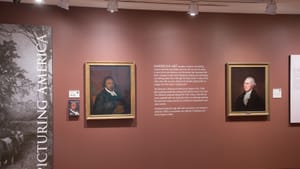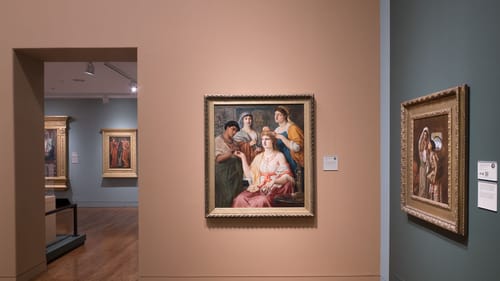Stay in the Loop
BSR publishes on a weekly schedule, with an email newsletter every Wednesday and Thursday morning. There’s no paywall, and subscribing is always free.
Same art, new eyes
Delaware Art Museum reimagines its permanent collection for a new era

Once created, most artworks remain stable, but as the world around them changes, meaning and interpretation are anything but static. Recent tectonic cultural shifts led the Delaware Art Museum to reimagine four of its permanent collections, resulting in 16 strikingly designed, thoughtfully interpreted, beautifully lit “new” galleries.
For these four “destination collections,” curatorial interpretations that were topical, accepted, or even groundbreaking 20 years ago give way to new narratives and scholarship. In preparation, the museum held several years of focus groups, asking what changes viewers might envision.
Prototyping and patience
An intensive self-study called prototyping also underpinned and guided the reinstallation. More commonly used in science museums, prototyping is somewhat unusual in the art world. For more than two years, visitors wrote impressions, questions, or suggestions on large sheets of paper or post-it notes on walls beside the artworks.
“We asked visitors to comment on what they saw in [our] collections and ultimately heard much about what they didn’t,” says Amelia Wiggins, assistant director of learning and engagement.
The pandemic dramatically affected timing; for more than two years, museum staff shuttered and reopened galleries on a demanding rolling schedule. With work now complete, the smooth flow and visual impact of the 16 spaces is due to impeccable curatorial scholarship and a keen sense of innovation. But the galleries also reflect the arduous work of museum registrars (who kept art safe and continuously monitored), preparators (who removed and re-hung hundreds of pieces), and the vision of highly lauded Philadelphia-area exhibition designer Keith Ragone, who found it “rare to be in a design process with a team so deeply committed.”
Picturing America
This view of American art from 1757-1900 now opens with “100 Years of Portraits.” Its signature image (generating the most feedback of any artwork during prototyping) is an arresting 1810 portrait of legendary Black leader Reverend Absalom Jones (1746-1818) by Raphaelle Peale (1774-1825). Jones’s life story unfolds with an in-depth audio stop and printed takeaway brochure written by Arthur K. Sudler, historian and archivist of the African Episcopal Church of St. Thomas, the Philadelphia institution with which Jones was most closely associated.

Throughout these four galleries are sculptures and painting showing elegant early American artistry, including a gorgeous room with a “salon hang:” gilded-age artworks stacked in 19th-century style. The museum also commissioned Charles Edward Williams to create I Sit and Sew: Tracing Alice Dunbar Nelson, a multimedia body of work honoring this important Delaware poet and activist, on view through February 6, 2022.
John Sloan and The Eight
DelArt holds the country’s pre-eminent collection of the art of John Sloan (1871-1951) and (in the Helen Farr Sloan Library) the painter’s archives. Like other American artists of that era, Sloan began his career as a popular illustrator in Philadelphia and continued to paint, though he sold only one painting before he turned 40. Sloan moved to New York City in 1904 and became pivotal in the group self-titled “The Eight,” who were often labelled by others as “The Ashcan School” for their realistic depictions of urban life.
A long wall is devoted to Sloan, including his lyrical and well-known Spring Rain (1912), a 1900 depiction of Philadelphia’s Walnut Street Theatre, and 10 of the artist’s famous Daumier-like etchings. There is an interactive section on activism and the role of the artist (The Eight were passionate activists) and arresting works by other members of this seminal group—George Luks, William Glackens, Ernest Lawson, Arthur B. Davies, Maurice Prendergast, and Robert Henri—that gave America a new view of the “Modern Metropolis.”
Radical Beauty: Art of the Pre-Raphaelites
This internationally known collection is the largest gathering of these 19th-century works outside of Great Britain. In four intimate newly installed galleries, excellent wall text explains why these artists titled themselves the “Pre-Raphaelite Brotherhood;” how they responded to Victorian industrialism and pollution; and why they were considered radicals, since the paintings actually look quite mainstream to us.
Women are featured both as artists and models. In a time when the art world largely barred women, male Pre-Raphaelites often served as mentors and art teachers. Newly acquired is Botticelli’s Studio, a large painting by Eleanor Fortescue-Brickdale (1872-1945), exceptionally rendered and filled with luscious detail.
A section on models of color includes the striking 2021 acquisition Academic Study of a Seated Male Nude (1868) by William Wise (1847-1889), and an audio tour features the story of Jamaican Pre-Raphaelite model Fanny Eaton narrated by her great grandson.

Still holding pride of place are two stunning wooden chairs painted by William Morris (1834-1896) and Edward Burne Jones (1833-1898), who shared a London flat as struggling artists. No IKEA for them: when they needed furniture, this is what they created. The exhibition’s fresh colors—celadon, peach, pale green—make paintings pop, along with William Morris wallpapers, their beautiful patterns still commercially available today.
Howard Pyle and American illustration
This collection’s six new galleries are the most expanded and expansive, with works by Howard Pyle (1853-1911), father of American illustration, and his legion of gifted disciples who have entered America’s visual lexicon. Along with Pyle’s iconic Mermaid, on entering the galleries you see the artist’s easel, chair, work stool, and a palette still slathered with paints in front of an oversized photomural of Pyle’s studio, giving a vibrant sense of the man. Chief curator Heather Campbell Coyle was “delighted to have the room to remove these items from our archives and share them with our visitors.”
Along with his famous summer studio in Wilmington, Pyle also taught at Drexel in Philadelphia, encouraging the talents of illustrators like Frank Schoonover, Jessie Wilcox Smith, Violet Oakley, and N.C. Wyeth—all seen in these galleries. Especially memorable are Pyle’s lighted stained-glass window (Anthony van Corlaer) and Violet Oakley’s massive, magnificent 1903 oil on canvas The Tempest and Hamlet, a study for a mural, her best-known genre.
Worth revisiting
The galleries are loosely organized by theme—pirates, knights and chivalry, American events—but the most memorable addition is a 15-minute video that movingly explores the societal skew that dominated American illustration of this period.
In the video, beloved illustrator Jerry Pinkney (who died in October) says that “one in four American cowboys were of African descent.” Artist John Lee points out that surrounding you are “images of a caste society.” Dr. Tonya Leslie, Temple University scholar and professor, notes that in these works “race is imagined in service and in the shadows.” University of Delaware teacher and illustrator Robyn Phillips-Pendleton speaks of the privilege and responsibility of creating new image pathways. And Ryan Hartley Smith (City University of New York) looks at the queer aspects of these images. The film is admirably direct, embracing, and impactful.
The museum’s drive for inclusivity was recently highlighted in the New York Times, which noted that the community involvement in writing wall text for a recent DelArt exhibition won plaudits from the American Alliance of Museums. No matter how often you may have visited, it’s worth a return to experience these collections afresh.
What, When, Where
Delaware Art Museum collections: Picturing America; John Sloan and The Eight; Radical Beauty: British Pre-Raphaelites; Howard Pyle and American Illustration. $6-$14; free during select hours. Delaware Art Museum, 2301 Kentmere Parkway, Wilmington, DE. 302-571-9590 or delart.org.
The Delaware Art Museum requires proof of Covid-19 vaccination to attend. Visitors are required to wear a mask.
Accessibility
The museum and outdoor Copeland Sculpture Garden are wheelchair-accessible, with free parking and a barrier-free entrance. Wheelchairs are available; personal care attendants receive free admission. Much of the museum’s collection, library, and archives are also available online.
Sign up for our newsletter
All of the week's new articles, all in one place. Sign up for the free weekly BSR newsletters, and don't miss a conversation.

 Gail Obenreder
Gail Obenreder